| Listing 1 - 10 of 17 | << page >> |
Sort by
|
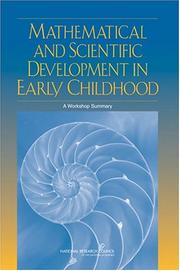
ISBN: 1280173726 9786610173723 0309546826 9780309546829 0309095034 9780309095037 9781280173721 6610173729 0309165423 9780309165426 Year: 2005 Publisher: Washington, D.C. : National Academies Press,
Abstract | Keywords | Export | Availability | Bookmark
 Loading...
Loading...Choose an application
- Reference Manager
- EndNote
- RefWorks (Direct export to RefWorks)
Mathematics --- Education, Preschool --- Study and teaching (Preschool)
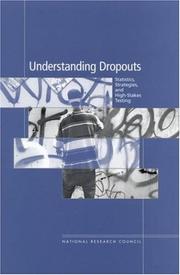
ISBN: 0309076021 0309510643 9780309510646 9780309076029 0305076021 0309170583 9780309170581 Year: 2001 Publisher: Washington, D.C. : National Academy Press,
Abstract | Keywords | Export | Availability | Bookmark
 Loading...
Loading...Choose an application
- Reference Manager
- EndNote
- RefWorks (Direct export to RefWorks)
Dropouts --- Educational tests and measurements --- Educational equalization --- Prevention.
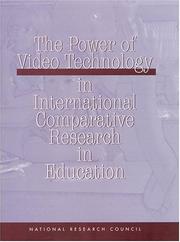
ISBN: 030907567X 0309511097 9780309511094 9780309075671 0309170672 Year: 2001 Publisher: [Washington, D.C.] : National Academies Press,
Abstract | Keywords | Export | Availability | Bookmark
 Loading...
Loading...Choose an application
- Reference Manager
- EndNote
- RefWorks (Direct export to RefWorks)
Comparative education. --- Video tapes in education. --- Education, Comparative --- Audio-visual education --- Education --- History
Book
ISBN: 1281726834 9786611726836 0309120365 9780309120364 9781281726834 0309120357 9780309120357 0309178541 Year: 2008 Publisher: Washington, D.C. : National Academies Press,
Abstract | Keywords | Export | Availability | Bookmark
 Loading...
Loading...Choose an application
- Reference Manager
- EndNote
- RefWorks (Direct export to RefWorks)
Educational evaluation --- Education --- Children --- Education, Primitive --- Education of children --- Human resource development --- Instruction --- Pedagogy --- Schooling --- Students --- Youth --- Civilization --- Learning and scholarship --- Mental discipline --- Schools --- Teaching --- Training --- Educational assessment --- Educational program evaluation --- Evaluation research in education --- Instructional systems analysis --- Program evaluation in education --- Self-evaluation in education --- Evaluation --- Standards
Book
ISBN: 1282454870 9786612454875 0309145643 9780309145640 0309145635 9780309145633 030914860X Year: 2009 Publisher: Washington, D.C. : National Academies Press,
Abstract | Keywords | Export | Availability | Bookmark
 Loading...
Loading...Choose an application
- Reference Manager
- EndNote
- RefWorks (Direct export to RefWorks)
"The deficiencies that many children experience from birth to school age--in health care, nutrition, emotional support, and intellectual stimulation, for example--play a major role in academic achievement gaps that persist for years, as well as in behavior and other problems. There are many intervention programs designed to strengthen families, provide disadvantaged children with the critical elements of healthy development, and prevent adverse experiences that can have lasting negative effects. In a climate of economic uncertainty and tight budgets, hard evidence not only that such interventions provide lasting benefits for children, their families, and society, but also that the benefits translate into savings that outweigh the costs is an extremely important asset in policy discussions. Convincing analysis of benefits and costs would provide a guide to the best ways to spend scarce resources for early childhood programs. Benefit-Cost Analysis for Early Childhood Interventions summarizes a workshop that was held to explore ways to strengthen benefit-cost analysis so it can be used to support effective policy decisions. This book describes the information and analysis that were presented at the workshop and the discussions that ensued"--Publisher's description.
Developmental disabilities --- Children with disabilities --- Child health services --- Children --- Maternal and child health services --- Mother and child health services --- Medical care --- Disabilities --- Developmentally disabled --- Prevention --- Research --- Government policy --- Services for --- Evaluation.
Book
ISBN: 0309260191 0309260175 Year: 2012 Publisher: Washington, District of Columbia : National Academies Press,
Abstract | Keywords | Export | Availability | Bookmark
 Loading...
Loading...Choose an application
- Reference Manager
- EndNote
- RefWorks (Direct export to RefWorks)
"Climate change is occurring, is very likely caused by human activities, and poses significant risks for a broad range of human and natural systems. Each additional ton of greenhouse gases emitted commits us to further change and greater risks. In the judgment of the Committee on America's Climate Choices, the environmental, economic, and humanitarian risks of climate change indicate a pressing need for substantial action to limit the magnitude of climate change and to prepare to adapt to its impacts. A principal message from the recent National Research Council report, America's Climate Choices, this brief summary of how climate change will shape many aspects of life in the foreseeable future emphasizes the vital importance of preparation for these changes. The report points to the importance of formal and informal education in supporting the public's understanding of those challenges climate change will bring, and in preparing current and future generations to act to limit the magnitude of climate change and respond to those challenges. Recognizing both the urgency and the difficulty of climate change education, the National Research Council, with support from the National Science Foundation, formed the Climate Change Education Roundtable. The roundtable brings together federal agency representatives with diverse experts and practitioners in the physical and natural sciences, social sciences, learning sciences, environmental education, education policy, extension education and outreach, resource management, and public policy to engage in discussion and explore educational strategies for addressing climate change. Two workshops were held to survey the landscape of climate change education. The first explored the goals for climate change education for various target audiences. The second workshop, which is the focus of this summary, was held on August 31 and September 1, 2011, and focused on the teaching and learning of climate change and climate science in formal education settings, from kindergarten through the first two years of college (K-14). This workshop, based on an already articulated need to teach climate change education, provided a forum for discussion of the evidence from research and practice. The goal of this workshop was to raise and explore complex questions around climate change education, and to address the current status of climate change education in grade K-14 of the formal education system by facilitating discussion between expert researchers and practitioners in complementary fields, such as education policy, teacher professional development, learning and cognitive science, K-12 and higher education administration, instructional design, curriculum development, and climate science. Climate Change Education in Formal Settings, K-14: A Workshop Summary summarizes the two workshops."--Publisher's description.
Climatic changes --- Climatic changes --- Study and teaching --- Evaluation. --- Education (Primary) --- Evaluation.
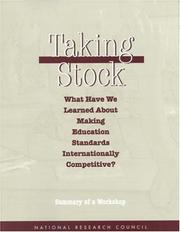
ISBN: 0309059445 0309370604 0585116121 9780585116129 9780309059442 Year: 1997 Publisher: Washington, District of Columbia : National Academy Press,
Abstract | Keywords | Export | Availability | Bookmark
 Loading...
Loading...Choose an application
- Reference Manager
- EndNote
- RefWorks (Direct export to RefWorks)
Mathematics --- Mathematical ability --- Science --- Education --- Physical Sciences & Mathematics --- Social Sciences --- Mathematics Teaching & Research --- Theory & Practice of Education --- Educational tests and measurements --- Evaluation --- Study and teaching --- Testing --- Standards --- Educational tests and measurements. --- Standards. --- Educational assessment --- Educational measurements --- Mental tests --- Tests and measurements in education --- Standards and standardization in education --- Standards-based education --- Psychological tests for children --- Psychometrics --- Students --- Examinations --- Psychological tests --- Rating of

ISBN: 0309065976 0309520304 0585085722 9780585085722 9780309065979 0305065976 9780309520300 0309184320 Year: 1999 Publisher: Washington, D.C. : National Academy Press,
Abstract | Keywords | Export | Availability | Bookmark
 Loading...
Loading...Choose an application
- Reference Manager
- EndNote
- RefWorks (Direct export to RefWorks)
Universities and colleges --- Educational tests and measurements --- SAT (Educational test) --- ACT Assessment --- Theory & Practice of Education --- Education --- Social Sciences --- Entrance examinations --- Admission --- ACT Assessment. --- Entrance examinations. --- Admission. --- ACT tests --- American College Testing Assessment --- SAT I (Educational test) --- SAT II (Educational test) --- Scholastic Aptitude Test --- Scholastic Assessment Test --- Scholastic Assessment Test I: Reasoning Test --- Scholastic Assessment Test II: Subject Tests --- Achievement tests
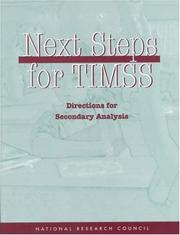
ISBN: 0309064287 0309517923 0585198063 9780585198064 0309073545 9780309073547 9780309064286 0305064287 9780309517928 0309173221 Year: 1999 Publisher: Washington, D.C. : National Academy Press,
Abstract | Keywords | Export | Availability | Bookmark
 Loading...
Loading...Choose an application
- Reference Manager
- EndNote
- RefWorks (Direct export to RefWorks)
Mathematics Teaching & Research --- Mathematics --- Physical Sciences & Mathematics --- Science --- Study and teaching --- Evaluation --- Third International Mathematics and Science Study --- Natural science --- Science of science --- Sciences --- Math --- TIMSS --- International Mathematics and Science Study, Third --- Third International Math and Science Study --- Natural sciences
Book
ISBN: 0309381207 0309381223 Year: 2016 Publisher: Washington, District of Columbia : The National Academies Press,
Abstract | Keywords | Export | Availability | Bookmark
 Loading...
Loading...Choose an application
- Reference Manager
- EndNote
- RefWorks (Direct export to RefWorks)
"Fertility rates and population growth influence economic development. The marked declines in fertility seen in some developing nations have been accompanied by slowing population growth, which in turn provided a window of opportunity for rapid economic growth. For many sub-Saharan African nations, this window has not yet opened because fertility rates have not declined as rapidly there as elsewhere. Fertility rates in many sub-Saharan African countries are high: the total rate for the region is estimated to be 5.1 births per woman, and rates that had begun to decline in many countries in the region have stalled. High rates of fertility in these countries are likely to contribute to continued rapid population growth: the United Nations projects that the region's population will increase by 1.2 billion by 2050, the highest growth among the regions for which there are projections. In June 2015, the Committee on Population organized a workshop to explore fertility trends and the factors that have influenced them. The workshop committee was asked to explore history and trends related to fertility, proximate determinants and other influences, the status and impact of family planning programs, and prospects for further reducing fertility rates. This study will help donors, researchers, and policy makers better understand the factors that may explain the slow pace of fertility decline in this region, and develop methods to improve family planning in sub-Saharan Africa"--Publisher's website.
Fertility, Human --- Population --- Africa, Sub-Saharan --- Social conditions
| Listing 1 - 10 of 17 | << page >> |
Sort by
|

 Search
Search Feedback
Feedback About UniCat
About UniCat  Help
Help News
News